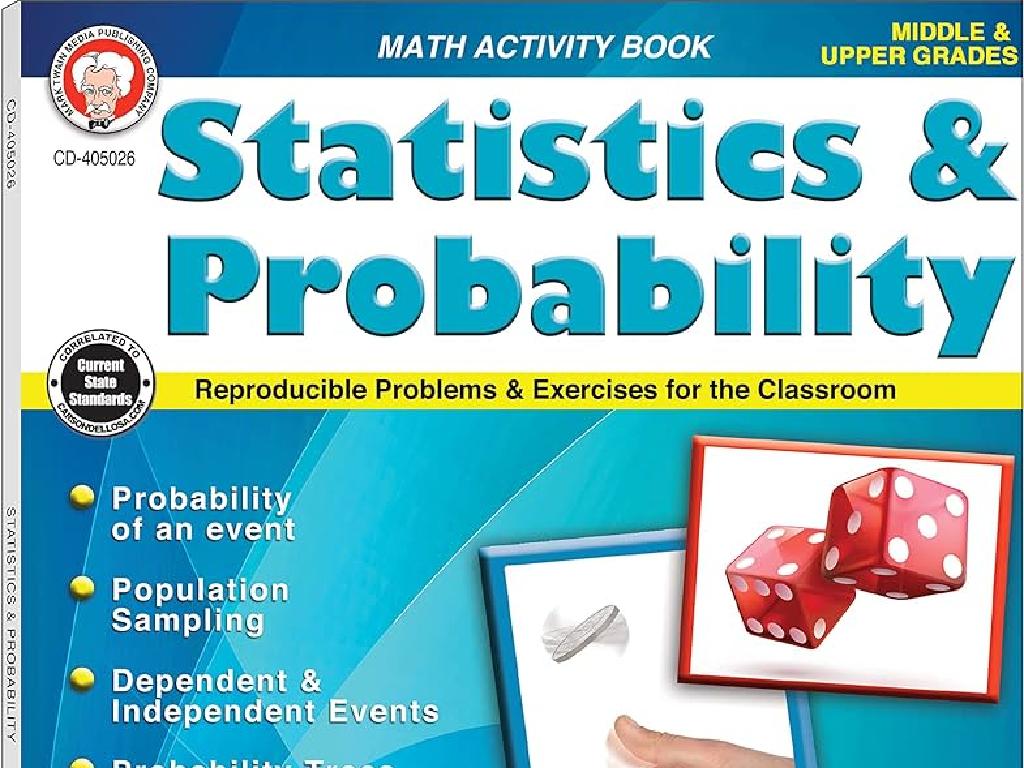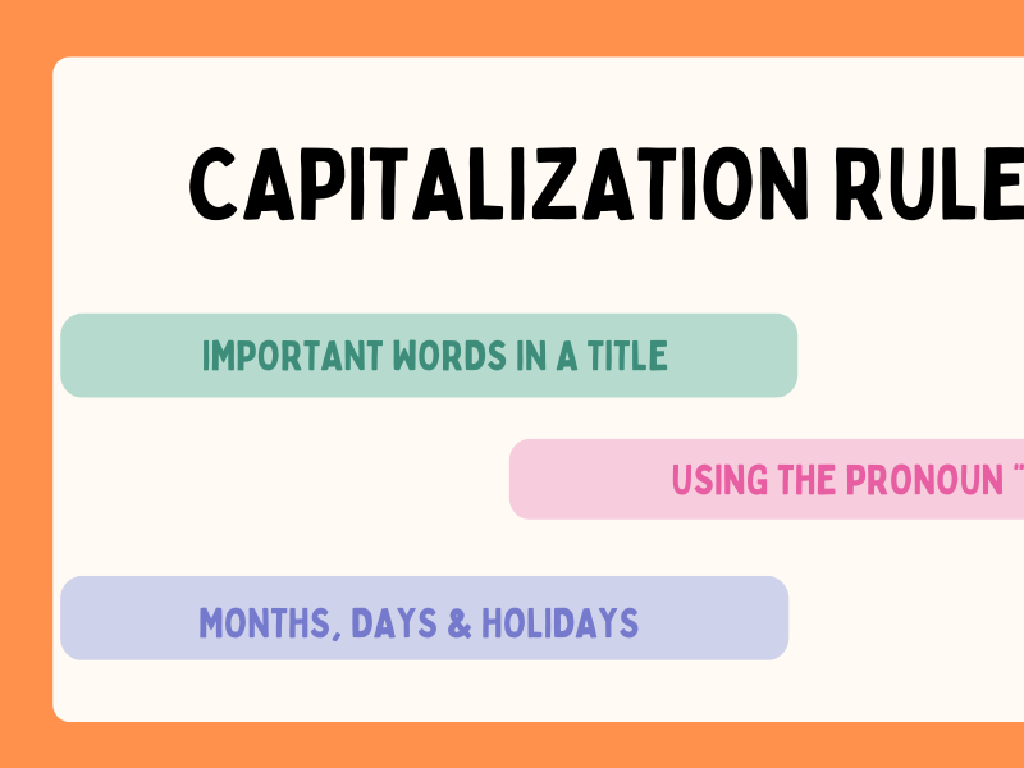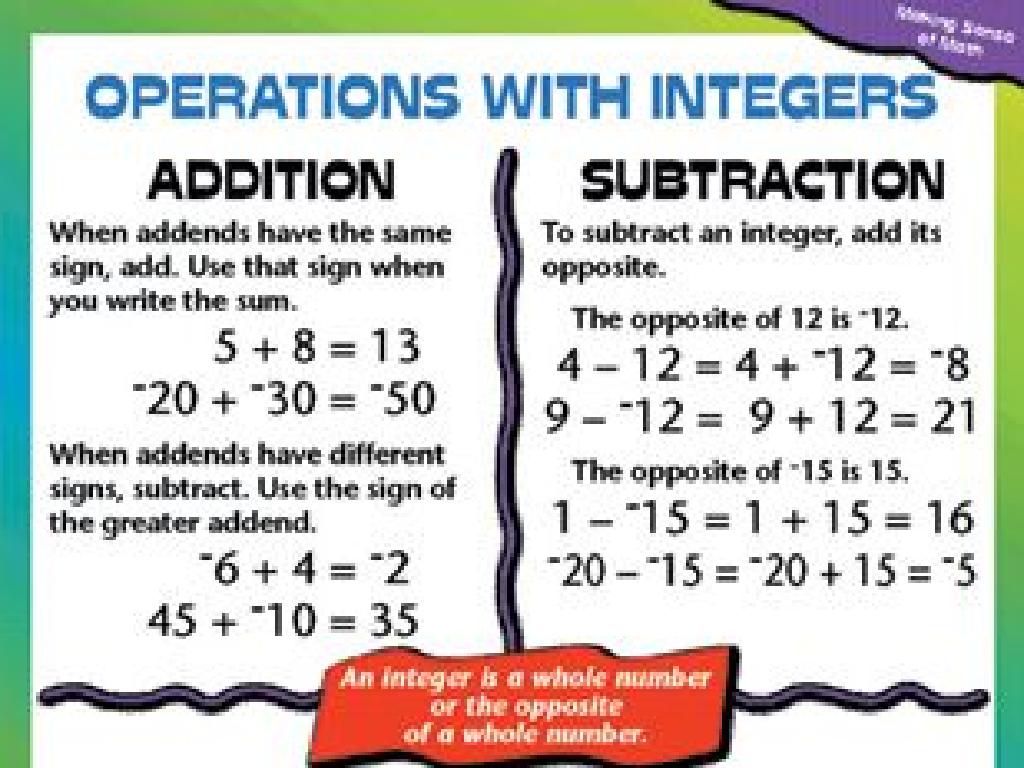Read Clocks And Write Times: Hour And Half Hour
Subject: Math
Grade: Second grade
Topic: Time
Summary: This engaging second grade math lesson teaches students how to read both analog and digital clocks, focusing on telling time to the hour and half-hour. Learners discover the roles of the hour and minute hands, practice setting and writing times, and participate in fun activities like crafting their own clocks. Through hands-on exercises, students build confidence in recognizing and writing times such as 3:00 and 3:30, helping them manage daily routines and develop essential time-telling skills.
Please LOG IN to download the presentation. Access is available to registered users only.
View More Content
Introduction to Time: Reading Clocks
– Greetings and welcome to learning time
– Today’s focus: Clocks and telling time
– Understanding time: Key to daily activities
– Knowing time helps us manage our day
– Importance of hours and half-hours
– We’ll learn to read time to the nearest half-hour
|
Begin the class with a warm welcome to set a positive tone for the lesson. Introduce the concept of time, emphasizing its importance in everyday life, such as knowing when to wake up, go to school, or have meals. Explain that understanding how to read clocks is a fundamental skill that will help them be punctual and responsible. Highlight that today’s lesson will focus on recognizing the hour and half-hour marks on a clock face. Use visual aids like a clock with movable hands to demonstrate. Encourage students to think of activities they do at specific times to make the concept relatable.
Understanding Time
– Time and events
– Time helps us know when things occur.
– Units of time
– We use seconds, minutes, and hours to measure time.
– Purpose of clocks
– Clocks assist us in monitoring time.
– Reading clocks
– Learn to read hours and half-hours on clocks.
|
This slide introduces the concept of time to second-grade students. Begin by explaining that time is a way to measure when events happen, from playing at recess to bedtime. Discuss the different units of time, emphasizing seconds, minutes, and hours, which are most relevant to their daily lives. Explain the purpose of clocks and how they help us keep track of time throughout the day. Finally, introduce the skill of reading clocks, focusing on recognizing the hour and half-hour marks. Use classroom clocks or visual aids to demonstrate. Encourage students to practice by looking at clocks at home and school.
Learning the Clock: Hour and Half Hour
– Clock parts: face, numbers, hands
– Short hand: shows the hour
– When the short hand points to 2, it’s 2 o’clock
– Long hand: shows minutes
– When the long hand points to 6, it’s half past the hour
– Reading hour and half-hour times
– Practice: What time is it when the short hand is at 3 and the long hand is at 6?
|
This slide introduces the basic components of a clock and how to read simple times to second graders. Emphasize the difference between the hour hand (short hand) and the minute hand (long hand). Use real clocks or classroom visuals to demonstrate. For example, when the short hand points to 3 and the long hand points to 12, it’s 3 o’clock. When the long hand points to 6, it’s half past the hour. Encourage students to practice with various times, focusing on the hour and half-hour marks. Activities can include setting the time on toy clocks, drawing the hands on a clock face worksheet, and identifying times on digital clocks.
Telling Time: Whole Hours
– Long hand at 12 means a whole hour
– Short hand shows which hour it is
– If the short hand is on 3, it’s 3 o’clock
– Let’s practice with some clocks
– We’ll look at different clocks and say the times out loud
|
This slide introduces students to the concept of telling time to the nearest hour. Emphasize that the long hand, or minute hand, being on 12 is the key indicator of a whole hour. The short hand, or hour hand, will point to the number of the hour it is. Use classroom clocks or printable clock faces to practice. Have students take turns reading the time out loud. For example, if the short hand points to 1 and the long hand is at 12, it is 1 o’clock. Encourage students to practice with their own watches or clocks at home. Prepare several examples of clocks showing different whole hours for the practice session.
Understanding Half Past the Hour
– Long hand at 6 means half past
– It’s halfway to the next hour
– Practice finding half past
– Can you point to half past on your clock?
– Let’s look at some clocks
– We’ll review examples together in class
|
This slide introduces the concept of ‘half past the hour’ to second-grade students. Begin by explaining that the long hand, or minute hand, on the clock points to the number 6 to indicate that 30 minutes of the hour have passed, which is halfway through the hour. Use visual aids like a toy clock or diagrams to demonstrate this concept. Encourage students to practice finding ‘half past’ on various clocks. Provide several examples and ask students to identify the time when the minute hand is on 6. Reinforce the concept by asking students to draw the minute hand on a clock face to show half past different hours. This interactive approach will help solidify their understanding of telling time to the half-hour.
Writing Time on Clocks
– Writing time with numbers
– Example: 3:00 for 3 o’clock
– When the big hand is on 12, it’s exactly the hour
– Example: 3:30 for half past three
– When the big hand is on 6, it’s half past the hour
– Practice writing times for clocks
– We’ll look at different clocks and write down the times shown
|
This slide is aimed at teaching second graders how to write time using numbers. Start by explaining that the short hand indicates the hour and the long hand shows the minutes. When the long hand is on 12, it’s exactly on the hour, which we write as ‘:00’. For half past an hour, when the long hand is on 6, we write ‘:30’. Use classroom clocks or drawings to practice. Have students write down times as you point to different hours and half hours. Encourage them to explain their reasoning for the times they write down to ensure understanding.
Practice Time: Reading Clocks
– Observe the clock hands
– Write the time shown
– Hour hand points to the hour
– If the hour hand is on 3, it’s 3 o’clock
– Minute hand points to 12 or 6
– If the minute hand is on 12, it’s on the hour; if on 6, it’s half past
|
This slide is an interactive activity for students to practice reading clocks and writing down the time. Encourage students to first identify the position of the hour hand and then the minute hand. Remind them that when the minute hand is on 12, it’s exactly on the hour, and when it’s on 6, it’s half past the hour. Provide several examples of clocks showing different times, and ask students to write down the time they see. This will help reinforce their understanding of how to read analog clocks. For the activity, consider using real clocks with movable hands, printable clock worksheets, or interactive whiteboard clocks where students can come up and set the time as described.
Class Activity: Craft Your Paper Clock
– Create your paper clock
– Set the clock to show times
– Use the hour and minute hands to show full and half hours
– Explain your time to a friend
– Tell your friend what time your clock shows
– Exchange clocks and practice
– Take turns to set and read times from each other’s clocks
|
This activity is designed to help students understand the concept of time by creating their own paper clocks. Provide each student with the necessary materials, including a paper plate, a fastener, and cut-outs for the clock hands. Guide them through the process of assembling the clock. Once assembled, instruct students to set their clocks to specific times, starting with the hour and then half-hour marks. Encourage them to explain the time they’ve set to a classmate. After sharing, they should exchange clocks and practice reading the time set by their friend. This hands-on activity not only reinforces their ability to read clocks but also enhances their communication skills as they explain and listen to time-telling. Prepare to assist students who may have difficulty and have additional exercises ready for those who finish early.
Time Mastery: Reading Clocks
– Congratulations on learning to read clocks!
– Recall: short hand shows the hour
– When the short hand points to 3, it’s 3 o’clock
– Recall: long hand shows minutes
– When the long hand points to 6, it’s half past the hour
– Keep practicing telling time!
|
Well done to all the students for their hard work in learning to read clocks! It’s important to remember the basics: the short hand indicates the hour, and the long hand points to the minutes. Reinforce the concept that when the long hand is on 12, it’s exactly the hour, and when it’s on 6, it’s half past. Encourage students to practice by looking at clocks throughout the day and telling the time to a friend, family member, or even to themselves. Frequent practice will help solidify their understanding and make telling time second nature.





